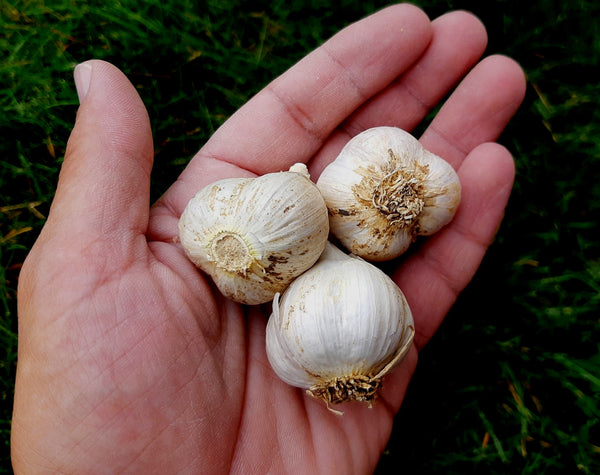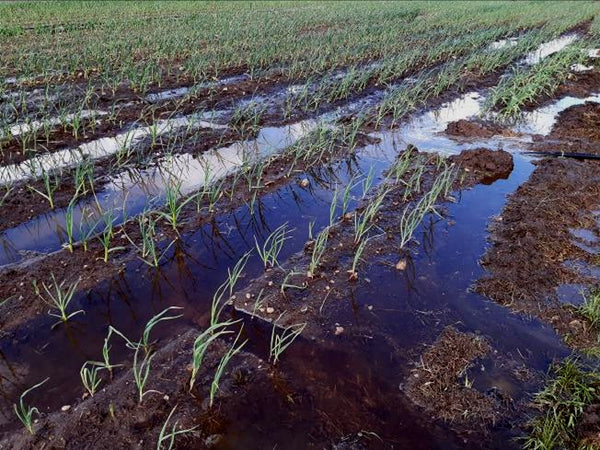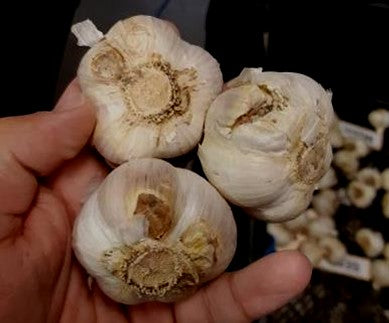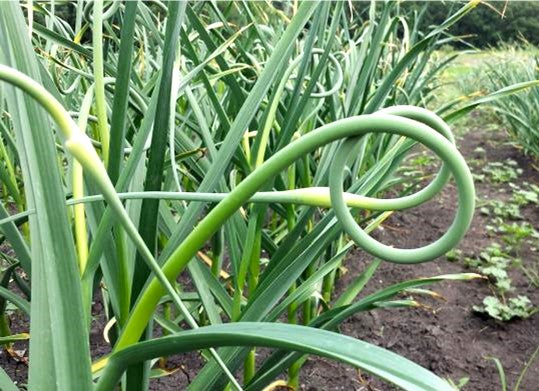Growing Garlic: 6 Reasons Why Garlic Bulbs Are Small At Harvest

Growing garlic can be a very rewarding activity, however, some growers end up disappointed when their bulbs end up being smaller than they expected at harvest time. It is actually quite common for new garlic growers (and sometimes even seasoned growers) to experience frustration about their garlic size. They are often left wondering what went wrong and whether or not there is something they could have done to improve their results.
Although there are many reasons why garlic bulbs can end up being small at harvest, here are the 6 most common causes.
(1) Poor Soil Conditions
Most soils are suitable for growing garlic, however, there are some situations like hard compacted soil that can cause the garlic plants to struggle. Poor soils almost always produce small garlic bulbs, unless they are improved in some way.
Garlic prefers deep loose soil, so hard compacted soils should be loosened deeply before planting. As well, all soils regardless of condition, benefit from adding large amounts of organic matter such as compost. This is especially true for heavy clay and light sandy soils.
Garlic grows very well in soils with high organic matter and benefits more than most vegetable crops to the addition of amendments. Organic matter holds onto excess nutrients and slowly releases them over a number of growing seasons. As well, it is extremely effective at improving soil structure and tilth. These are all factors that help garlic plants reach their full potential for growth.

Loose fertile soil that grows large garlic bulbs
(2) Poor Fertility
Garlic is a heavy feeder and requires high soil fertility to perform at its best. When nutrients like Nitrogen, Phosphorus and Potassium are at optimum levels, plant growth is healthy and bulb size is maximized. Poor soil fertility is a very common reason for poor bulb size and can be easily avoided with proper planning.
Many inexperienced growers believe that adding a thin layer of amendments such as compost is enough to meet the fertility needs of their garlic. They sometimes also believe that a “healthy application” of manure several years prior is adequate. Although it is true that soils benefit greatly from adding organic matter, it does not necessarily mean that nutrient levels will be high enough for the garlic to reach its full potential.
Soil testing is the best way to see if the soil has high enough fertility to grow healthy plants. Without testing it can be assumed that the soil is low in fertility and fertilizer can be added at recommended levels.
For more information on fertility see How To Fertilize Your Garlic Properly.
(3) Too Much Competition
Garlic plants need lots of space both below ground for their roots and above ground for their leaves to access full sunlight. There are usually two ways that garlic can end up with too much competition. The first is by planting the cloves too closely and having the garlic plants crowd each other. The second is by allowing weeds to take over and compete with the growing plants. Both restrict the amount of nutrients, moisture and sunlight that each garlic plant receives, resulting in poor growth and small bulb size.

Garlic that has been completely taken over by weeds
Spacing:
When trying to grow large bulbs, it is best to plant the garlic rows at least 12 inches apart and 6 to 8 inches between plants within the row. This will give each individual plant plenty of space to grow and the best chance to achieve maximum bulb size.
Planting closer than this is possible, however, the garlic plants will end up shading each other, reducing the amount of total sunlight each individual plant will receive. Also, the plant roots will compete more vigorously with each other for water and nutrients, likely resulting in smaller bulbs.
Weeding:
Controlling weeds is also extremely important and act similar to planting too closely. Garlic is an incredibly poor competitor that requires constant weeding throughout the growing season. Weed pressure is one of the greatest threats to good bulb size and good yields. Ideally, garlic plants should grow in a completely weed free environment for the entire growing season.
When weeding, it is important to be careful not to damage the garlic plant roots as they are relatively shallow growing and can be fragile. Weed removal, while the weeds are still very small, makes weeding much easier and helps keep the depth of the soil disturbance shallower.
(4) Too Little or Too Much Moisture
Garlic is a surprisingly thirsty vegetable crop that requires consistent moisture throughout the season to maximize its growth. Dry soil conditions, especially during the bulbing phase, will result in significantly smaller bulb sizes at harvest. Even one bad dry spell for a week or two during the growing season can cause disappointing results.
On clay and loam soils, approximately 1 inch (2.5 cm) of water per week is required during the growing season. On sandy soils, 2 inches (5.0 cm) or more of water is often required during hot, dry weather. Watering should be reduced once the garlic has matured and it is almost time to harvest. This will help with the harvesting process and improve the conditions of the bulb wrappers by reducing their deterioration as harvest approaches.
The best time of day for irrigation is during the morning or mid-afternoon. This allows enough time for the plant foliage to dry before cooler temperatures arrive in the evening.
Excess water for long periods of time where the soil is saturated can also cause garlic bulbs to suffer. If the garlic roots are submerged in water for too long, some of them can become stunted or even die back, resulting in poor bulb size.

Poorly drained garlic field after a heavy rain
(5) Poor Quality Seed
When planting garlic, it is very important to start with healthy seed stock. This means using quality cloves that are firm, disease free and have not started to sprout. Any planting material that looks questionable should be discarded or used for other purposes like cooking.

Damaged and diseased garlic bulbs that are not suitable for planting
Also, it is best to use large cloves as these tend to produce the biggest bulbs when planted. This means that when you crack (break up) a bulb, the largest cloves are the best ones for seed stock. Some growers will still plant the smaller ones and harvest them as spring garlic (similar to green onions) or allow them to mature knowing that the bulbs will likely be somewhat smaller at harvest.
Bulbs and cloves come in a wide range of sizes depending on the variety. Some varieties like those in the Porcelain family have very big cloves no matter the size of the bulb. Other varieties like Silverskin tend to have bulbs with a large number of small cloves. When growing large cloved varieties most of the cloves can be planted with great success. When growing small cloved varieties, it is best to use the largest cloves for maximum bulb growth.
(6) Scape Removal
When growing hardneck varieties, scape removal is very important. This is because energy is conserved and diverted to the bulb rather than the flowering structure. If a grower forgets to remove the scapes, the bulb size can be reduced by as much as 30% or 40%.

Scape Ready to be cut and harvested
Scapes are usually snapped off by hand or cut with shears just above the last leaves once they begin to curl. You want the cut to dry as quickly as possible in order to prevent a route for infection or diseases.
This means it is best to do the removal during dry weather whenever possible. Scapes are wonderful to eat and can be used in cooking like scallions or green onions. Once harvested they can be stored for up to 3 or 4 weeks.
For more information on growing garlic, see our other blog articles or growing garlic pages.
About the Author: John Côté owns and operates John Boy Farms with his family who have been farming the same land for over 140 years. As an agronomist and experienced farmer, he helps others learn how to farm and grow garlic successfully. He has written many articles and is the author of The Master Guide to Growing Big Garlic.
